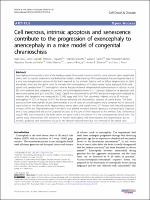| dc.contributor | Vall d'Hebron Barcelona Hospital Campus |
| dc.contributor.author | Oria, Marc |
| dc.contributor.author | Duru, Soner |
| dc.contributor.author | Figueira, Rebeca L |
| dc.contributor.author | Scorletti, Federico |
| dc.contributor.author | Turner, Lucas E |
| dc.contributor.author | Fernandez-Alonso, Irati |
| dc.contributor.author | Fernández Martín, Alejandra |
| dc.contributor.author | Marotta Baleriola, Mario |
| dc.date.accessioned | 2020-08-04T10:41:25Z |
| dc.date.available | 2020-08-04T10:41:25Z |
| dc.date.issued | 2019-09-26 |
| dc.identifier.citation | Oria M, Duru S, Figueira RL, Scorletti F, Turner LE, Fernandez-Alonso I, et al. Cell necrosis, intrinsic apoptosis and senescence contribute to the progression of exencephaly to anencephaly in a mice model of congenital chranioschisis. Cell Death Dis. 2019 Sep 26;10:721. |
| dc.identifier.issn | 2041-4889 |
| dc.identifier.uri | https://hdl.handle.net/11351/5134 |
| dc.description | Amniotic fluid; Neonatal mortality; Exencephaly |
| dc.description.abstract | Exencephaly/anencephaly is one of the leading causes of neonatal mortality and the most extreme open neural tube defect with no current treatments and limited mechanistic understanding. We hypothesized that exencephaly leads to a local neurodegenerative process in the brain exposed to the amniotic fluid as well as diffuse degeneration in other encephalic areas and the spinal cord. To evaluate the consequences of in utero neural tissue exposure, brain and spinal cord samples from E17 exencephalic murine fetuses (maternal intraperitoneal administration of valproic acid at E8) were analyzed and compared to controls and saline-injected shams (n = 11/group). Expression of apoptosis and senescence genes (p53, p21, p16, Rbl2, Casp3, Casp9) was determined by qRT-PCR and protein expression analyzed by western blot. Apoptosis was measured by TUNEL assay and PI/AV flow cytometry. Valproic acid at E8 induced exencephaly in 22% of fetuses. At E17 the fetuses exhibited the characteristic absence of cranial bones. The brain structures from exencephalic fetuses demonstrated a loss of layers in cortical regions and a complete loss of structural organization in the olfactory bulb, hippocampus, dental gyrus and septal cortex. E17 fetuses had reduced expression of NeuN, GFAP and Oligodendrocytes in the brain with primed microglia. Intrinsic apoptotic activation (p53, Caspase9 and 3) was upregulated and active Caspase3 localized to the layer of brain exposed to the amniotic fluid. Senescence via p21-Rbl2 was increased in the brain and in the spinal cord at the lamina I-II of the somatosensory dorsal horn. The current study characterizes CNS alterations in murine exencephaly and demonstrates that degeneration due to intrinsic apoptosis and senescence occurs in the directly exposed brain but also remotely in the spinal cord. |
| dc.language.iso | eng |
| dc.publisher | Springer Nature |
| dc.relation.ispartofseries | Cell Death & Disease;10 |
| dc.rights | Attribution 4.0 International |
| dc.rights.uri | http://creativecommons.org/licenses/by/4.0/ |
| dc.source | Scientia |
| dc.subject | Fetus - Cervell - Malformacions |
| dc.subject | Rates (Animals de laboratori) |
| dc.subject | Líquid amniòtic |
| dc.subject.mesh | Nervous System Malformations |
| dc.subject.mesh | /mortality |
| dc.subject.mesh | Mice, Neurologic Mutants |
| dc.subject.mesh | Amniotic Fluid |
| dc.title | Cell necrosis, intrinsic apoptosis and senescence contribute to the progression of exencephaly to anencephaly in a mice model of congenital chranioschisis |
| dc.type | info:eu-repo/semantics/article |
| dc.identifier.doi | 10.1038/s41419-019-1913-6 |
| dc.subject.decs | malformaciones del sistema nervioso |
| dc.subject.decs | /mortalidad |
| dc.subject.decs | ratones mutantes neurológicos |
| dc.subject.decs | líquido amniótico |
| dc.relation.publishversion | https://www.nature.com/articles/s41419-019-1913-6 |
| dc.type.version | info:eu-repo/semantics/publishedVersion |
| dc.audience | Professionals |
| dc.contributor.authoraffiliation | [Oria M, Duru S, Fernandez-Alonso I] Center for Fetal and Placental Research, Cincinnati Children's Hospital Medical Center (CCHMC), Cincinnati, USA. [Figueira RL] Center for Fetal and Placental Research, Cincinnati Children's Hospital Medical Center (CCHMC), Cincinnati, USA. Laboratory of Experimental Fetal Surgery "Michael Harrison", Division of Pediatric Surgery, Department of Surgery and Anatomy, Ribeirao Preto Medical School, University of Sao Paulo-USP, Ribeirao Preto, Brazil. [Scorletti F] Center for Fetal and Placental Research, Cincinnati Children's Hospital Medical Center (CCHMC), Cincinnati, USA. Department of Pediatric Surgery, Hospital Bambino Gesu, Rome, Italy. [Turner LE] The Chicago Institute for Fetal Health, Ann & Robert H. Lurie Children's Hospital of Chicago, Chicago, USA. Department of Pediatric Surgery, Northwestern University, Feinberg School of Medicine, Chicago, USA. [Fernandez-Martin A, Marotta M] Center for Fetal and Placental Research, Cincinnati Children's Hospital Medical Center (CCHMC), Cincinnati, USA. Laboratori de Bioenginyeria, Teràpia Cel•lular i Cirurgia en Malformacions Congènites, Vall d'Hebron Institut de Recerca (VHIR), Barcelona, Spain. Universitat Autònoma de Barcelona, Barcelona, Spain |
| dc.identifier.pmid | 31558708 |
| dc.identifier.wos | 000488854900011 |
| dc.rights.accessrights | info:eu-repo/semantics/openAccess |


